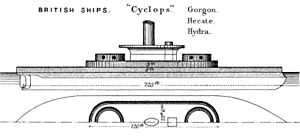HMS Hecate (1871)
For other ships of the same name, see HMS Hecate.
 Right elevation plan from Brassey's Naval Annual 1888–1889 | |
| Career (United Kingdom) | |
|---|---|
| Name: | HMS Hecate |
| Namesake: | Hecate |
| Builder: | J & W Dudgeon, Cubitt Town, London |
| Cost: | £156,782 |
| Laid down: | 5 September 1870 |
| Launched: | 30 September 1871 |
| Completed: | 24 May 1877 |
| Commissioned: | April 1872 |
| Out of service: | 1901 |
| Refit: | 1885–86 |
| Fate: | Sold for scrap 12 May 1903 |
| General characteristics | |
| Class and type: | Cyclops-class breastwork monitor |
| Displacement: | 3,480 long tons (3,540 t) |
| Length: | 225 ft (68.6 m) (p/p) |
| Beam: | 45 ft (13.7 m) |
| Draught: | 16 ft 3 in (5.0 m) (deep load) |
| Installed power: | 1,579 ihp (1,177 kW) |
| Propulsion: | 2 shafts, 2 steam engines |
| Speed: | 10.5 knots (19.4 km/h; 12.1 mph) |
| Range: | 3,000 nmi (5,600 km; 3,500 mi) at 10 kn (19 km/h; 12 mph) |
| Complement: | 156 |
| Armament: | 2 × 2 - 10-inch rifled muzzle loaders |
| Armour: | Belt: 6–8 in (152–203 mm) Deck: 1.5 in (38 mm) Superstructure: 8–9 in (203–229 mm) Conning tower: 8–9 in (203–229 mm) Gun turret: 9–10 in (229–254 mm) |
HMS Hecate was the last ship completed of the four Cyclops-class breastwork monitors built for the Royal Navy during the 1870s.
Service history
Together with her sister ships, the Cyclops and the Gorgon, she was placed on the non-effective list of ships in January 1902,[1] and sold for scrap the following year.
References
- Ballard, G. A., Admiral (1980). The Black Battlefleet. Annapolis, MD: Naval Institute Press. ISBN 0-87021-924-3.
- Gardiner, Robert, ed. (1979). Conway's All the World's Fighting Ships 1860–1905. Greenwich: Conway Maritime Press. ISBN 0-8317-0302-4.
- Parkes, Oscar (1990). British Battleships (reprint of the 1957 ed.). Annapolis, MD: Naval Institute Press. ISBN 1-55750-075-4.
- Silverstone, Paul H. (1984). Directory of the World's Capital Ships. New York: Hippocrene Books. ISBN 0-88254-979-0.
- ↑ "Naval & Military intelligence" The Times (London). Monday, 6 January 1902. (36657), p. 8.
| ||||||||||